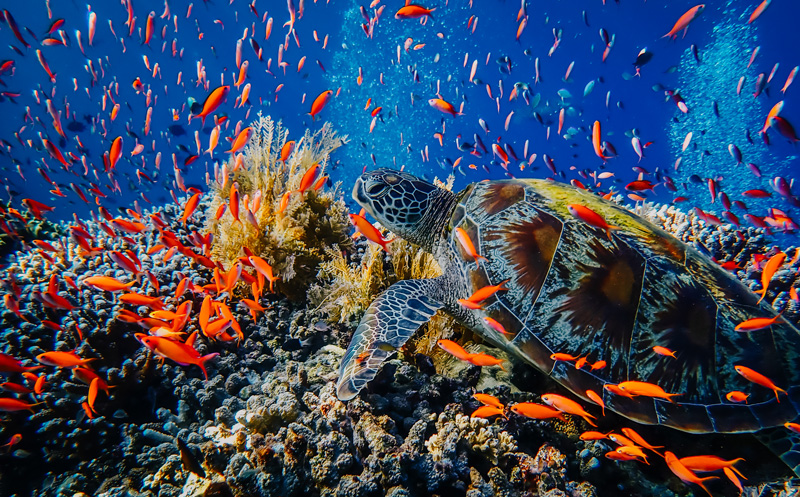
One of the highlights of Raja Ampat are its corals and its great marine biodiversity, it’s known to be one of the last places in the world where you can still find alive corals with vivid colours and amazing textures that you can’t miss. And of course, the mass variety of sea species you can find: From macro diving with a big variety of nudibranchs and the tiny pigmy seahorse, to “rare” species like the “walking shark” or the Wobbeggong (aka The Lazy shark), going through ancient giant sea turtles, mantas, sharks, and the most hard-to-see Dugongs.
Also, in some months and areas you can experience the bioluminescence in the water.
Is it clear that if you are a diver or snorkeler, this is your place!
Around all the islands you can find amazing reefs, but there are always the most famous and wanted spots with it’s amazing coral or their stunning schools of fish that will surround you until the sunlight is gone.
RAJA AMPAT ONLY FOR DIVERS? Absolutely not!
Raja Ampat is an underwater paradise for snorkelers too. Its shallow, crystal-clear waters are full of life—vibrant corals, colorful fish, turtles, and even reef sharks… all without the need for tanks!
In many spots, snorkeling here is just as spectacular as diving—if not more—and much more accessible. All you need is a mask and a sense of wonder.
Don’t miss it: Raja Ampat from the surface is pure magic.
BASIC INFORMATION FOR DIVERS
The best months to visit Raja Ampat are from October until March/April.
There’s some Diving Centres around Raja Ampat and your homestay usually links you with them.
The diving Centres usually do 2 or 3 dive spots in the morning and 1 or 2 in the afternoon. You can also ask for a night dive and this could be the cherry on the cake.
If you want to dive in Raja Ampat, we recommend you to tell in advance to your homestay to manage your dives. In some months dive centres are crowded and it’s possible that you can’t find a place when you arrive.
The Homestays you’ll find in this website will manage your dives so you can travel with no worries about that. Book your room now!
MARINE PARK ENTRY
There is two kinds of entry fee. One it will be charged right at the entrance of the marine park, before picking your transfer boat to your homestay. This is the “Tiket Masuk Pengunjung” and it costs 300.000 IDR /person
And then the “Environmental Maintenance Services Fee” Card for diving and snorkelling (and they will ask for it if you want to see the Mantas). Bring this card always with you, even while you are going to dive.
We know that some webs tell you that you don’t need to ask for the second one, but authorities can ask you to show them, it’s a risk and we strongly believe it’s important to obtain them in order to keep helping Raja Ampat to be an example of marine conservation. If you need any help we will be pleased to help you, with the cooperation of everyone we will continue keeping this jewel untouched.
You can find more information about this mandatory fee or proceed to get the card by yourself here: Marine Park Entry.
DIVING CERTIFICATE/LEVEL
As you can see we haven’t specified the diving license you need, and it’s because the certificate doesn’t guarantee your level and capacities, so we recommend you to always follow your local instructor instructions because it will be crucial to have a safe and pleasant dive. Although some diving spots seem calm, Raja Ampat is also known by its currents that can be unpredictable and quite strong. Instructors are acquainted with the currents of the area and they know how to read the ocean to identify them. Trust them, following their instructions will help avoiding dangerous situations.
We want to remind that the kind of diving we use to practice in Raja Ampat is safe and they are non-deco dives, so you don’t need to worry anything about.
But we would like to remark that is very important which company are you diving with. Be always cautious and check well your gear before diving.
Okay, let’s dive into some famous diving and snorkelling spots:










